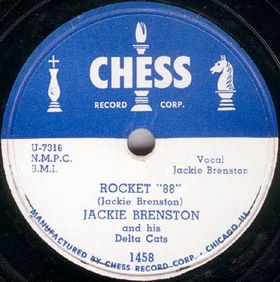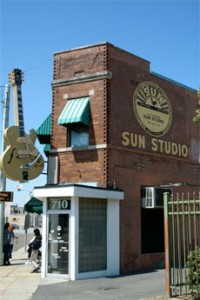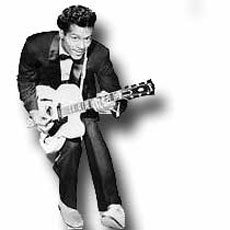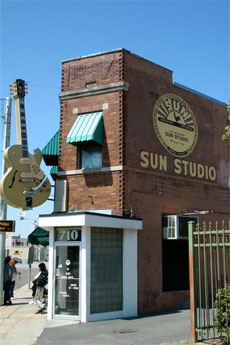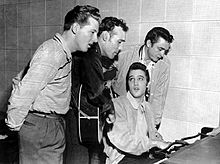Sam Phillips, also known as the “Father of Rock ‘n’ Roll,” was a pioneering American record producer and the founder of Sun Records in Memphis, Tennessee. Throughout his career, Phillips played a crucial role in shaping the sound and direction of rock and roll, and his impact on the genre continues to be felt today.
Phillips grew up in rural Alabama, where he developed a love for blues, gospel, and country music. After working as a radio DJ and sound engineer, he opened Sun Records in 1952, with the goal of recording and producing music that reflected the sounds he heard in the South. It was through Sun Records that Phillips discovered and recorded some of the most influential artists in rock and roll history, including Elvis Presley, Johnny Cash, Carl Perkins, Roy Orbison, and Jerry Lee Lewis.
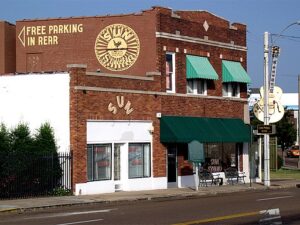
Phillips’ contributions to the development of rock and roll are numerous and varied. Firstly, he was instrumental in popularizing the sounds of black blues and gospel musicians, which had previously been ignored by the mainstream music industry. Through his recordings and production, Phillips helped to bring these artists and their music to a wider audience, influencing the sound and style of early rock and roll.
Innovations in Recording
Secondly, Phillips was known for his innovative recording techniques and his willingness to experiment with new sounds and styles. He was among the first producers to use echo and reverb to enhance the sound of his recordings, and he was also one of the first to utilize multiple microphone setups in the studio. These innovations helped to create the distinctive “Sun sound,” which became synonymous with the early days of rock and roll.
Finally, Phillips’ influence extends beyond his production work and into the realm of artist development. He was a mentor and a sounding board for many of the musicians he worked with, and he helped to guide their careers and encourage their artistic visions. For example, he famously challenged Elvis Presley to find a unique style that would set him apart from other musicians, leading to Presley’s development as one of the most iconic figures in rock and roll history.
Sam Phillips Finds Elvis
Sam Phillips discovered Elvis Presley through a series of chance encounters. In the early 1950s, Presley was a struggling truck driver who had a passion for music and had made a few amateur recordings. One day, he walked into Sun Records in Memphis and asked to record a song as a gift for his mother. Phillips was intrigued by Presley’s raw talent and unique sound, and he offered to record him professionally.
Presley returned to Sun Records several times to make additional recordings, and Phillips began to see potential in the young musician. He encouraged Presley to incorporate elements of black blues and gospel music into his sound, and he helped him to refine his style and stage presence. Eventually, Phillips signed Presley to a recording contract, and he went on to become one of the most famous and influential figures in rock and roll history.
It is said that Phillips recognized something special in Presley’s voice and his ability to connect with audiences, and he was willing to take a chance on the young artist despite the lack of interest from other record labels. This willingness to take risks and to support new and innovative talent was a hallmark of Phillips’ career, and it was a key factor in his success as a record producer and his role in shaping the history of rock and roll.
Johnny Cash
Sam Phillips discovered Johnny Cash in the early 1950s when Cash was still a young man serving in the United States Air Force. After completing his military service, Cash visited Sun Records in Memphis and auditioned for Phillips. Impressed by Cash’s deep and distinctive voice, Phillips offered him a recording contract and helped to shape his sound and style.
Phillips encouraged Cash to incorporate elements of country and folk music into his recordings, and he also encouraged him to write his own songs. This combination of Cash’s natural talent and Phillips’ production expertise resulted in a series of hit recordings that helped to establish Cash as one of the most influential figures in the country and rockabilly genres.
In addition to his work with Cash, Phillips also recorded other influential musicians such as Carl Perkins and Jerry Lee Lewis, who, along with Presley and Cash, became known as the “Million Dollar Quartet.” These artists helped to define the sound and style of early rock and roll, and Phillips’ role as a producer and mentor to these musicians was critical to their success and to the development of the genre.
Altogether, Sam Phillips’ contributions to the history of rock and roll are immense. He helped to popularize the sounds of black blues and gospel music, pushed the boundaries of recording technology, and played a key role in the development of many of the most iconic artists in the genre. Today, his legacy lives on through the countless musicians and producers who have been influenced by his work, and his impact on the music world continues to be felt decades after his death.

